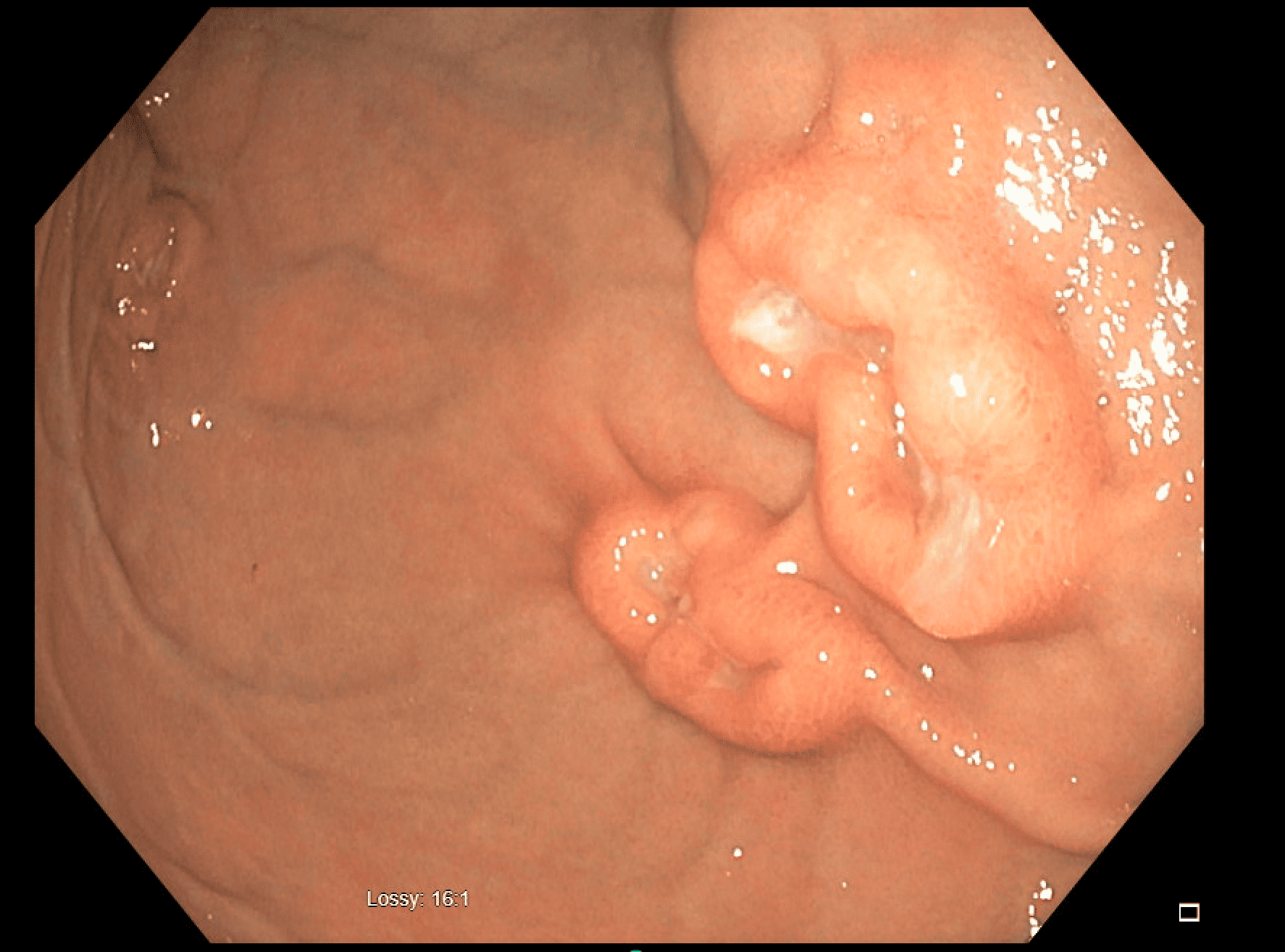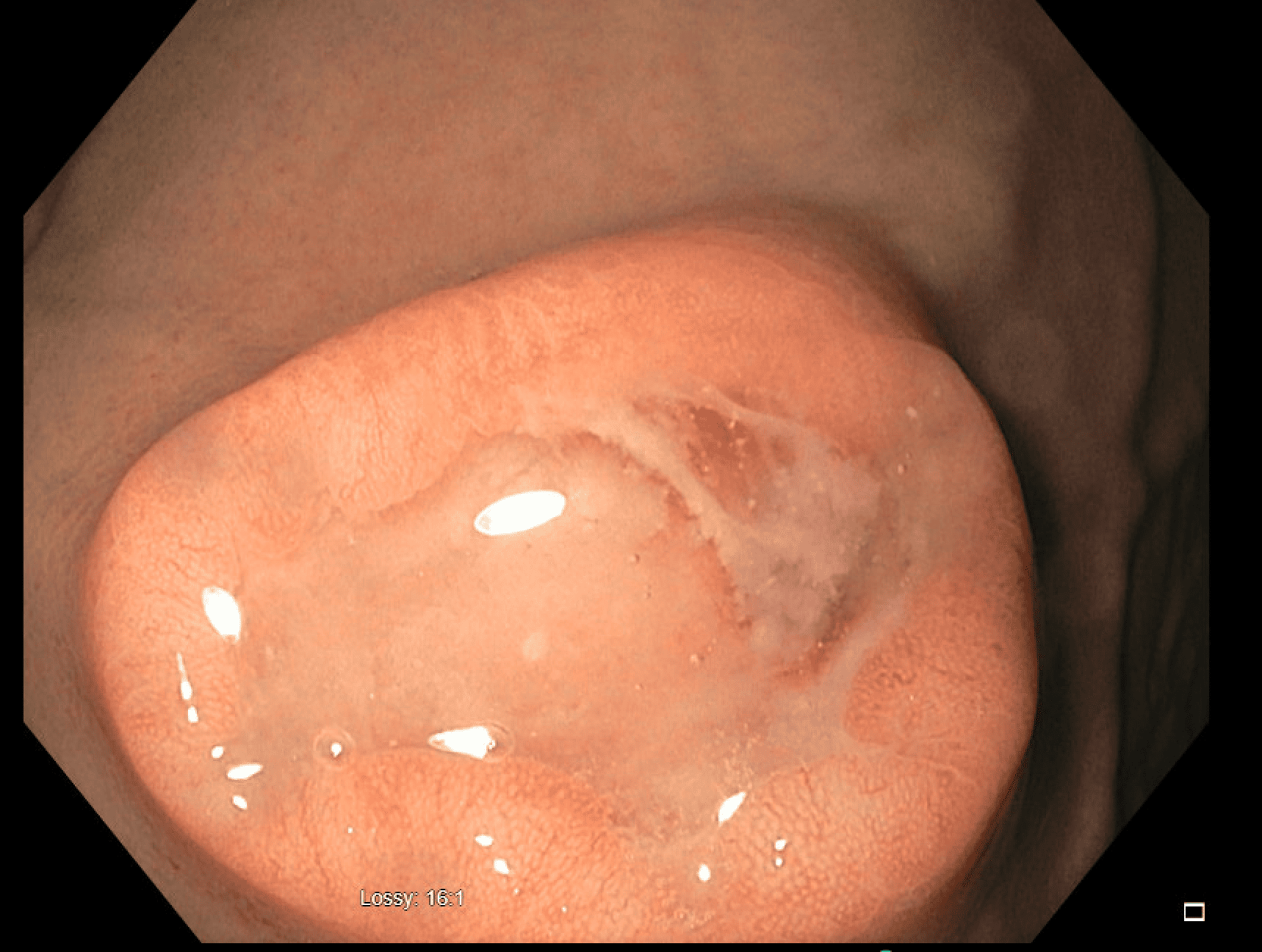Tuesday Poster Session
Category: Stomach and Spleen
P6347 - Primary Gastric Diffuse Large B-Cell Lymphoma Presenting With Recurrent Hematemesis
Tuesday, October 28, 2025
10:30 AM - 4:00 PM PDT
Location: Exhibit Hall

Ankita Nekkanti, MD
University of Illinois College of Medicine
Peoria, IL
Presenting Author(s)
Ankita Nekkanti, MD, Navjit Singh, MD, Hasan Shoaib, MD, Jason Bill, MD
University of Illinois College of Medicine, Peoria, IL
Introduction: Primary gastric lymphoma is an uncommon malignancy, accounting for approximately 3% of gastric cancers, with diffuse large B-cell lymphoma (DLBCL) being the most prevalent subtype. It typically occurs between ages 50–60, with a slight male predominance. Presenting symptoms are often vague, including epigastric pain, anorexia, early satiety, weight loss, or B symptoms. If bleeding occurs, it is usually occult. Overt gastrointestinal bleeding, particularly recurrent hematemesis, is a less common presentation. We report a striking case of primary gastric DLBCL in a young adult male who presented with recurrent hematemesis and was found to have multifocal deep gastric ulcers.
Case Description/
Methods: A 25-year-old man with no significant medical history presented with melena and multiple episodes of large-volume hematemesis. Laboratory evaluation revealed a hemoglobin drop from 13 g/dL to 8 g/dL, consistent with acute blood loss anemia. Esophagogastroduodenoscopy (EGD) showed approximately 10 deep, cratered ulcerative lesions, each 1–2 cm in size, distributed throughout the gastric fundus and body. None were actively bleeding. Endoscopic ultrasound (EUS) confirmed mucosal and submucosal involvement without deeper invasion. Biopsies revealed DLBCL, germinal center B-cell (GCB) subtype. Positron Emission Tomography (PET) scan demonstrated hypermetabolic lesions in the bilateral ribs without significant nodal or visceral involvement, consistent with primary gastric lymphoma with limited osseous spread. Due to recurrent hematemesis and transfusion-dependent anemia, the patient was admitted and started on chemotherapy with R-CHOP (Rituximab, Cyclophosphamide, Doxorubicin, Vincristine, Prednisone). He remains under close follow-up to assess response.
Discussion: Recurrent, large-volume hematemesis is an uncommon presentation of gastric DLBCL. Endoscopic findings are variable and may include erythema, nodularity, mass lesions, or benign-appearing ulcers. The presence of numerous deep ulcerative lesions in the gastric body and fundus is atypical. This case underscores the importance of prompt endoscopic evaluation and histologic diagnosis in young patients with GI bleeding of unclear origin and highlights the need to include lymphoma in the differential.

Figure: Multiple deep, cratered ulcerative lesions noted in the gastric body.

Figure: Large gastric ulcer with heaped up edges.
Disclosures:
Ankita Nekkanti indicated no relevant financial relationships.
Navjit Singh indicated no relevant financial relationships.
Hasan Shoaib indicated no relevant financial relationships.
Jason Bill indicated no relevant financial relationships.
Ankita Nekkanti, MD, Navjit Singh, MD, Hasan Shoaib, MD, Jason Bill, MD. P6347 - Primary Gastric Diffuse Large B-Cell Lymphoma Presenting With Recurrent Hematemesis, ACG 2025 Annual Scientific Meeting Abstracts. Phoenix, AZ: American College of Gastroenterology.
University of Illinois College of Medicine, Peoria, IL
Introduction: Primary gastric lymphoma is an uncommon malignancy, accounting for approximately 3% of gastric cancers, with diffuse large B-cell lymphoma (DLBCL) being the most prevalent subtype. It typically occurs between ages 50–60, with a slight male predominance. Presenting symptoms are often vague, including epigastric pain, anorexia, early satiety, weight loss, or B symptoms. If bleeding occurs, it is usually occult. Overt gastrointestinal bleeding, particularly recurrent hematemesis, is a less common presentation. We report a striking case of primary gastric DLBCL in a young adult male who presented with recurrent hematemesis and was found to have multifocal deep gastric ulcers.
Case Description/
Methods: A 25-year-old man with no significant medical history presented with melena and multiple episodes of large-volume hematemesis. Laboratory evaluation revealed a hemoglobin drop from 13 g/dL to 8 g/dL, consistent with acute blood loss anemia. Esophagogastroduodenoscopy (EGD) showed approximately 10 deep, cratered ulcerative lesions, each 1–2 cm in size, distributed throughout the gastric fundus and body. None were actively bleeding. Endoscopic ultrasound (EUS) confirmed mucosal and submucosal involvement without deeper invasion. Biopsies revealed DLBCL, germinal center B-cell (GCB) subtype. Positron Emission Tomography (PET) scan demonstrated hypermetabolic lesions in the bilateral ribs without significant nodal or visceral involvement, consistent with primary gastric lymphoma with limited osseous spread. Due to recurrent hematemesis and transfusion-dependent anemia, the patient was admitted and started on chemotherapy with R-CHOP (Rituximab, Cyclophosphamide, Doxorubicin, Vincristine, Prednisone). He remains under close follow-up to assess response.
Discussion: Recurrent, large-volume hematemesis is an uncommon presentation of gastric DLBCL. Endoscopic findings are variable and may include erythema, nodularity, mass lesions, or benign-appearing ulcers. The presence of numerous deep ulcerative lesions in the gastric body and fundus is atypical. This case underscores the importance of prompt endoscopic evaluation and histologic diagnosis in young patients with GI bleeding of unclear origin and highlights the need to include lymphoma in the differential.

Figure: Multiple deep, cratered ulcerative lesions noted in the gastric body.

Figure: Large gastric ulcer with heaped up edges.
Disclosures:
Ankita Nekkanti indicated no relevant financial relationships.
Navjit Singh indicated no relevant financial relationships.
Hasan Shoaib indicated no relevant financial relationships.
Jason Bill indicated no relevant financial relationships.
Ankita Nekkanti, MD, Navjit Singh, MD, Hasan Shoaib, MD, Jason Bill, MD. P6347 - Primary Gastric Diffuse Large B-Cell Lymphoma Presenting With Recurrent Hematemesis, ACG 2025 Annual Scientific Meeting Abstracts. Phoenix, AZ: American College of Gastroenterology.
